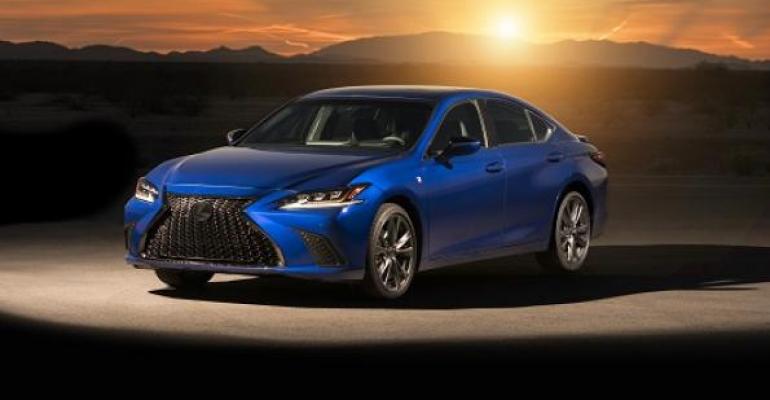RANCHO PALOS VERDES, CA – Lexus is counting on bolder styling and better performance to draw more buyers to its ES sedan, unveiled in its seventh generation simultaneously here and at the Beijing auto show.
Set to hit U.S. showrooms in September, the ’19 model is spun from Toyota’s TNGA global platform, or as Lexus refers to it in this application, the GA-K (Global Architecture-K). Lexus says the new architecture rivals the rear-drive LC coupe and LS sedan’s GA-L platform in torsional stiffness. Like the TNGA-based Camry and Avalon, the ES will be built at Toyota’s Georgetown, KY, plant.
With the new model, shown to U.S. media on the grounds of the seaside Terranea resort, comes the first-ever ES F Sport. Although the performance model features the same 3.5L V-6 and new 8-speed automatic standard in the base car, the F Sport does add Lexus’ Adaptive Variable Suspension featured on the LC coupe. The suspension includes adjustable dampers – with 650 possible levels of damping force – for optimum control over any road surface.
The F Sport also adds an exclusive Sport+ mode in the Drive Mode Select system that dials in the most aggressive suspension and powertrain settings. Activation triggers a new Engine Sound Enhancement feature that adds an extra layer to the V-6’s exhaust tone.
The standard engine gets a huge boost in power from the outgoing model, as horsepower jumps to 302 from 268 and torque gains 19 lb.-ft. (26 Nm) to 267 lb.-ft. (362 Nm), enhancing performance even with the base model. Lexus says the standard automatic uses an ultra-thin torque converter and multi-plate lock-up clutch to more efficiently transfer power to the front wheels.
The transaxle also features a wider spread of ratios, meaning it can provide for quick jumps off the line and high fuel efficiency at cruising speeds. Fuel-economy ratings have not been released on the standard engine, however.
Optional is Toyota’s fourth-generation Hybrid Drive System, which marries Toyota’s 2.5L gasoline 4-cyl. with a nickel-metal-hydride battery and what Lexus says is a more compact, power-dense electric motor. Combined output is 215 hp and here Lexus lists preliminary fuel economy at 44 mpg (5.3 L/100 km) city/highway.
Styling arguably is the bigger play with the new model, however. The ES is the third vehicle after the LC and LS in what Lexus calls its “Future Chapter,” meant to expand the brand’s appeal to a larger audience.
The revamped ES is sleekly sculptured around its aggressive signature grille. Its lowered hood and downwardly slanted silhouette makes for a design treatment Lexus calls “provocative elegance.” It features a much sportier stance with its slightly lower profile and increased length and width. Its wheels have been pushed further thanks to a 2-in. (5-cm) extension in wheelbase. Bold, chiseled lines in the sides that rise from the front to the rear add to the car’s strong character.
“The ES has always been an elegant luxury sedan,” Project Chief Designer Yasuo Kajino says in a statement. “For this generation, we have added daring design elements that challenge the traditional expectations of buyers.”
There are two grille treatments to distinguish the ES 350 and hybrid ES 300h from the ES 350 F Sport. The former cars get vertical bars that radiate out from the center, while the F Sport features a blacked-out pattern consisting of L-shaped clusters and corresponding cutouts at each corner of the fascia.
At the rear are LED taillamps that wrap around the quarter panels. The F Sport adds a rear spoiler, badging and a dark lower valance. It also gets 19-in. wheels, rather than the 17- or 18-in. discs available on the other models.
The ES cockpit is more driver-oriented than the outgoing car, with its center, more horizontal screen and controls angled toward the driver, and the dash design sweeping away from the passenger side. The F Sport gets unique Hadori aluminum trim, inspired by the traditional Japanese sword, that features fluctuating wave patterns for a three-dimensional appearance. It is the first use of the material for Lexus.
Standard is the Lexus Safety System+ 2.0 that includes daytime bicyclist detection as part of its pre-collision system and an enhanced pedestrian-at-night detection system.
The ES is the first Lexus to offer Apple CarPlay. It also is Amazon Alexa-enabled and includes Verizon Wi-Fi as part of an optional navigation system with a 12.3-in. (31-cm) screen. Standard is an 8-in. (20-cm) display.
The restyled ES enters a U.S. segment that is holding its own despite the overall market’s shift toward CUVs, with sales up 1.2% through the first quarter. Deliveries of the ES, still Lexus’s top sedan, are off 2.6% over that period to 9,263 units. Overall Lexus car sales are down 9.4%.
But Toyota has benefited from aggressive redesign work for its Camry midsize sedan, whose sales are up 8.8% in the first quarter, and it is counting on the revamped ES, which is following an identical game plan, to generate similar results.
[email protected] @DavidZoia





